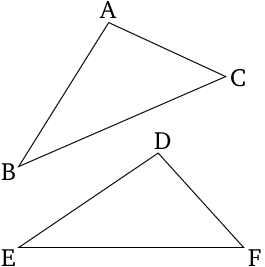If two triangles have two sides equal to two sides, respectively, but (one) has a base greater than the base (of the other), then (the former triangle) will also have the angle encompassed by the equal straight lines greater than the (corresponding) angle (in the latter).

If two triangles (\(\triangle{ABC}\), \(\triangle{DEF}\)) have two sides of one triangle (\(\overline{AB}\), \(\overline{AC}\)) respectively equal to two sides of the other (\(\overline{DE}\), \(\overline{DF}\)), where the base of one \((\overline{BC})\) is greater than the base of the other \((\overline{EF})\), then the angle \((\angle{BAC})\) contained by the sides of the triangle with the longer base \((\triangle{ABC})\) is greater in measure than the angle \((\angle{EDF})\) contained by the sides of the other triangle \((\triangle{DEF})\).
In shorter words, if \(\overline{AB}=\overline{DE}\), \(\overline{AC}=\overline{DF}\), and \(\overline{BC} > \overline{EF}\), then \(\angle{BAC} > \angle{EDF}\).1
Note: This is a conversion of proposition 1.24. ↩